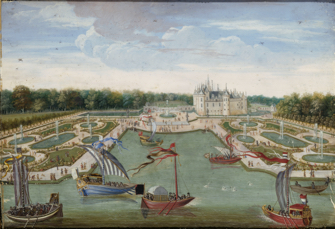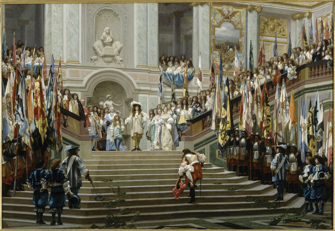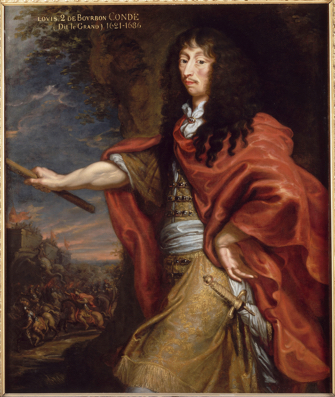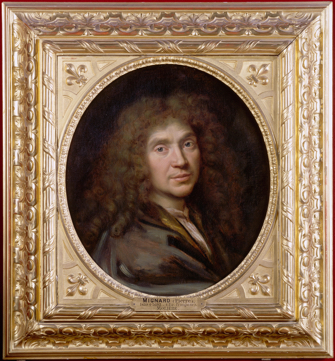
It may seem unlikely, but Chantilly Castle, for many years the home of the Condé dynasty, has only now devoted an exhibition, “Le Grand Condé: Le Rival du Roi-Soleil?,” to perhaps its most illustrious inhabitant, Louis de Bourbon, Prince de Condé (1621-86), a cousin of Louis XIV.
Renowned as a brilliant general, the young Condé (whose title was then Duc d’Enghien) commanded, fought and won for France some of the most remarkable battles of the 17th century.
During the period of civil strife known as the Fronde in the late 1640s and early 1650s, however, Condé was imprisoned by and then fought against the Regent, Anne of Austria (Louis XIV’s mother) and Cardinal Mazarin, her first minister. Condé subsequently went into exile and fought for the enemy, the Spanish, during the Franco-Spanish War.
After that war ended in 1659, Louis XIV

allowed Condé to return to France on condition that he swear allegiance to his monarch. Back at his château, Condé concentrated on the expansion and beautification of the buildings and gardens at Chantilly, amassing impressive collections of art and becoming patron and supporter to some of the greatest writers of the age, including Molière, Racine, Corneille and La Fontaine.
This exhibition duly commemorates the various phases in Condé’s career. He had generated an impressive propaganda machine to spread the word about his prowess, and his military successes are celebrated in numerous portraits of him – the artists had their work cut out for them, as his weak chin and large nose

made it difficult to depict him in a flattering way – and of his greatest battles. Many songs, probably commissioned by Condé, were sung on the streets of Paris praising his military victories. Given that Chantilly owns many of these songs in manuscript form, it is unfortunate that none of them are on show.
Most of the paintings depicting his battles are not of very good quality, but anyone interested in military strategy will enjoy the exhibit that explains in great detail the maneuvers that led to perhaps his greatest victory, the Battle of Rocroi in 1643 during the Thirty Years War, against the hitherto invincible Army of Flanders.
Condé’s patronage of the arts is amply covered by the exhibition, with a pair of portraits by Van Dyck and works by such French contemporary painters as Charles Le Brun and Pierre Mignard. I particularly loved Le Brun’s preparatory drawings for “Bacchus and Ariadne,” which reminded me of similar drawings by Poussin.
A number of first editions of works by writers Condé supported are also on display, including Corneille’s Rodogune, which was dedicated to Condé; Molière’s Tartuffe (Condé strongly supported performances of the play during

Molière’s battle with religious factions that wanted it banned); and Racine’s Phèdre. There are also first editions of two of the funeral orations given after Condé’s death (by Jacques-Bénigne Bossuet, the greatest preacher of the day, and Louis Bourdaloue).
Some interesting episodes of Condé’s life are featured, such as the suicide at Chantilly of the chef Vatel in 1671 after a fish delivery did not arrive on time during a visit by Louis XIV, but other aspects are passed over too quickly, such as the fact that Condé kept his wife (a niece of Cardinal Richelieu, whom he believed to be beneath his high royal rank) locked up in a castle far from Chantilly.
Also, no mention is made of Condé’s love for various men (a predilection he shared with his father), who formed a permanent part of his circle (they were referred to disparagingly as his “petits maîtres,” or “little masters”). It seems strange that such facts should still be airbrushed out of an exhibition in the 21st century.
Another drawback of the show is that, while the wall texts are in both French and English, the labels (virtually impossible to read in any event, as the print is so small and the light so dim) are in French alone.
Although the exhibition on its own might not merit the 25-minute train trip from Paris, if you wish to see the gorgeous castle and gardens (and enjoy the good restaurant in the castle itself, La Capitainerie – set in Vatel’s former kitchen – with lots of Chantilly cream on the menu, of course), it would be well worth spending an hour learning about an extraordinary figure in 17th-century French history.
Favorite